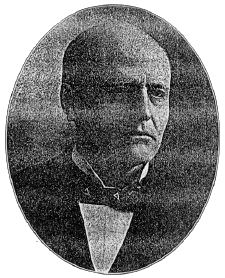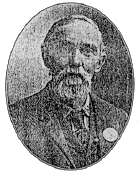|
Addison C. Beach, Weeping Water, Born
in Ashtabula county, Ohio, October 21, 1834, died October
2nd; drove overland from Ohio to Weeping Water in 1866.
J. G. P. Hildebrand, pioneer editor, born
in Keokuk county, Iowa, died in Lincoln, October 8th, where
he had resided for more than twenty-five years, appointed
deputy internal revenue collector for the Lincoln district
in 1913, and held the office until his death.
Mrs. Anna Katherine Wetenkamp, Lincoln,
born in Germany, April 2, 1833, died October 8th; married
John L. Wetenkamp at Manitowoc, Wisconsin in 1856; drove
overland to Cass county in 1861; in 1862 removed to
Lancaster county, homesteading on what is now the O street
road six miles from Lincoln.
William Dunn, pioneer of Syracuse 1858,
died October 9th. He was a well known overland freighter
across the plains.
Melville Sperry Wilcox, Burt county; born
in Litchfield, New York, September 20, 1842; died October
9th.
Frank T. Hamilton, born in Omaha in 1861,
died October 11th. He was president of the Omaha Gas
Company, vice president of the Merchants National Bank and
president of the Omaha & Council Bluffs Street Railway
Company, succeeding Gurdon W. Wattles.
Abraham Towner, veteran of the Civil War,
born in Missouri in 1836, died at his home in Butler county
October 12th.
Josiah Kent, 83 years old, died in Omaha,
October 14th; came by wagon from Philadelphia to Nebraska in
1857.
Mrs. Salina Guss Mettlen, pioneer of Wayne
county, 1861, died October 14th.
Melville S. Cox, Burt county, was born in
Litchfield, New york, September 20, 1842; died at his home
near Tekamah, October 16th; settled near Elk Creek, Douglas
county, in 1867.
Mrs. Margaret Prendergast McDermott,
pioneer of Omaha before 1860; died October 21st.
Rebecca Evans, resident of Nebraska since
1866, died at Liberty, Neb., October 21, at the age of 92
years.
Mrs. Elizabeth Knoell, Fremont, died
October 22; having resided continuously in Dodge county
since 1865.
John B. Colton, owner of Buzzards' Roost
ranch near Eddyville, Neb., died at Grand Island, October
23rd. Hamersley's Army and Navy Register records that he
became captain and then quartermaster of the Eighty-third
Regiment Illinois Volunteer infantry, November 26, 1862 and
resigned November 17, 1863. He was active in the
organization of his regiment and resided at Galesburg, the
place from which he enlisted, from 1836, when he was five
years old until the time of his death, with the exception of
twenty-four years spent in Kansas City. He was on his way
from Galesburg to his ranch in Nebraska when he was stricken
with pneumonia which caused his death at Grand Island. It is
said that his estate amounted to more than a million
dollars, most of which was invested in stock of the Chicago,
Burlington & Quincy Railroad Company. Colonel Colton, as
he was commonly known, acquired his Nebraska ranch, which
contained about 5,000 acres, thirty-five years ago.
Mrs. P. S. Gibbs died at Craig, November
6th. She and her husband were very early settlers in Burt
county.
Eldora Dell Kunnemann Beezley, pioneer of
Syracuse, 1863, died November 11th.
Mrs. Mary A. Pearman, widow of Major J. W.
Pearman, died at Crawford, Neb., November 9th; married at
Rockport, Mo., February 4th, 1856; came with her husband to
Nebraska City, where he had settled in 1854. The Pearman
family were among the best know early settlers. Major
Pearman bore the title "Squatter Governor" and was a witty
newspaper writer.
Walter Parker, Johnson, Neb., died
November 13; born in England in 1841, came to the United
States in 1866 and the same year to Brownville, after twenty
years moved to Johnson.
Hiram Burch, University Place; first
minister of the Methodist Episcopal denomination ordained in
Nebraska, died November 15th; born in Canada December 11,
1829; arrived in Nebraska City, November 29th, 1855, to
become pastor of the Methodist Episcopal church. Mr. Burch
assisted in establishing the Methodist Seminary at Peru and
in the organization and development of the Methodist college
at York.
Fred Krug, pioneer Omaha resident and
first Nebraska brewer died November 18th. He was born near
Cassel, Germany, in 1833; came to America at the age of
nineteen; arrived in Omaha February 13, 1859, and in that
year established the first brewery of that town. He was a
heavy investor in many Omaha enterprises among which was the
Krug theatre. He is survived by his wife to whom he had been
married over sixty-three years.
Amelia Holland, pioneer of Saunders county
since 1867, died November 19th.
John E. Caselman, Julian, Neb., died
November 21st at the age of eighty-four years; born in
Ontario, Canada, in 1835; came to Nebraska in 1859, settling
first in Nebraska City; enlisted at that place September 9,
1861 in Company C, of the Curtis Horse Nebraska Volunteers,
which was merged into the Fifth Iowa Cavalry June 25, 1862;
honorably discharged at Nashville in 1864, having served
three years and thirty-seven days.
John A. Foster, Omaha, Neb., died November
22; born in the East Indies in 1836; served in the British
army in the Crimean war; enlisted in the Civil War in the
16th New York Provisional Cavalry; He was a cornetist and
played at the inauguration and at the funeral services of
Abraham Lincoln. Mr. Foster also served in the Indian wars
and was a survivor of the Fort Sill massacre. He came to
Nebraska in 1866.
|
William A. Taylor, pioneer of
Plattsmouth since 1857, died, November 24th.
Mrs. Lucinda Bolejack, Shubert, resident
of Nebraska since 1862, died November 24th.
Mathias Kubicek, pioneer big Blue
precinct, Saline county, since 1856, died November 25th.
Mrs. George Higgins, a resident of Omaha
for fifty-five years, died November 27th.
Charles Wesley Lockwood, Gibbon, died
November 27th, came to Nebraska in 1867.
James Kleihauer, Johnson, died November
27th, born in Hanover, Germany, in 1834, came to America in
1845, settled in Nemaha county in 1865, where he resided
until his death.
Mrs. Lena M. Chalfant, Nebraska City,
daughter of Daniel Gantt, justice of the supreme court of
Nebraska 1873-1878, died December 2nd, resident of Nebraska
since 1860.
Joseph Frank Portrey, Falls City, resident
of Nebraska since 1863; died December 3rd.
Mrs. Sarah Jane Wood, pioneer Dakota City
in 1858, died December 3rd at Woodbine, Iowa.
John K. Watson, Peru, died December 4th,
at the age of 92 years; resided in Nemaha county for 53
years.
Mrs. D. C. Cole, Peru, died in Omaha
December 6th; born in Bureau county, Illinois, March 14,
1843; came to Nebraska in 1857, where she resided until her
death.
Daniel B. Hall, Minden, veteran of the
Civil war and resident of Nebraska since 1866, died December
10th.
William R. Babcock, Jefferson county
pioneer, died December 10th, having lived his entire life of
54 years in the county.
Mrs. Elizabeth E. Goodwin, resident of
Nebraska since 1860, died in Plattsmouth December 11th.
David Silvers Reed, Syracuse, veteran of
the Civil war, died December 11th; came to Nebraska in
1864.
John K. Watson, pioneer Nemaha county
since 1865, died December 11th.
Mrs. Mary a. Teats, a resident of Fremont
since 1857, died in Blair, December 11th.
Mrs. Ella Byrne, 83 years old and a
resident of Omaha since 1866, died December 11th.
Mrs. William Burrow, Humboldt, died
December 12th; born in Russia, January 22, 1814; came to
America in 1858, settling at Brownville.
William John Fowlie, pioneer Bennet since
1866, died December 14th.
Dighton W. Hotaling, pioneer of Johnson
county, 1865, died in Holyoke, Colo., December 19th.
John Nelson, resident of Cedar county for
more than sixty years, died December 21st.
George A. Mayer, Lincoln, died December
22nd; came to Nebraska in 1859, settling at Plattsmouth;
removed to Lancaster county in 1862 where he resided until
his death.
Mrs. Mary D. Hauptman, resident of
Nebraska since 1860, died in Lincoln, December 25th.
James Armstrong, resident of Auburn since
the early sixties, died in San Diego, Calif., December
28th.
Mrs. Henry Halbeck, pioneer Dodge county
since 1865, died October 25th.
Herman Henry Stork, born December 1, 1838,
in Germany, settled at Arlington in 1865; died October
26th.
Johannes Christian Wunner, resident of
Stanton and vicinity for fifty-four years, died October
28th.
Conrad Bauman, pioneer of Sarpy county in
1866, died October 29, in Georgetown, Colo.
James Harrison Cook, born in Otoe county,
September 12, 1865, died November 1; spent his life in
Nebraska until his removal to Spokane, Wash., in 1911.
Richard Whitehead, resident of Lancaster
county since 1867, died November 4; entered employ of the
postoffice October 15, 1884, as mail carrier and at the time
of his death was the oldest carrier in point of service.
Mrs. Anson B. Crabtree, Maywood, Neb.,
died November 5th; moved with her parents to Iowa in 1849,
settled in Cass county, Nebraska in the very early
fifties.
Mrs. Andres Everett, Lyons, Neb., who
settled in the Logan valley in 1867, died November 6th.
A War Program
The program at the annual meeting of
the Historical Society for 1920 was designed to place in our
records some of the first hand material upon Nebraska's part
in the World War while the actors were living and the facts
fresh in their minds. The program follows:
Demobilization and Return to Peace
....... Governor S. R. McKelvie
The Nebraska Fuel Administration
.......... John L. Kennedy, Omaha
The Nebraska National Guard ........ Col.
P. L. Hall, Jr., Greenwood
The Nebraska State Council of Defense
........ R. M. Joyce, Lincoln
The History of Burt County in the World
War ...............................
.........................................................
J. R. Sutherland, Tekamah
The Three Hundred Fifty-fifth Regiment
.......................................
..................................................
Capt. Earl Cline, Nebraska City
|

